The most beautiful pictures of the cosmos September 2012go
 Bashny.Net
Bashny.Net
21 Fota will not break
steal here
In the constellation of Dorado is a huge cluster of R136, which consists of the largest, hottest, most massive stars known. It contains more than 100,000 stars. The total mass of the cluster R136 is estimated at 450,000 solar masses. Here are 12 very massive and bright stars from 37 to 76 mass of our sun. (Photo: NASA, ESA):
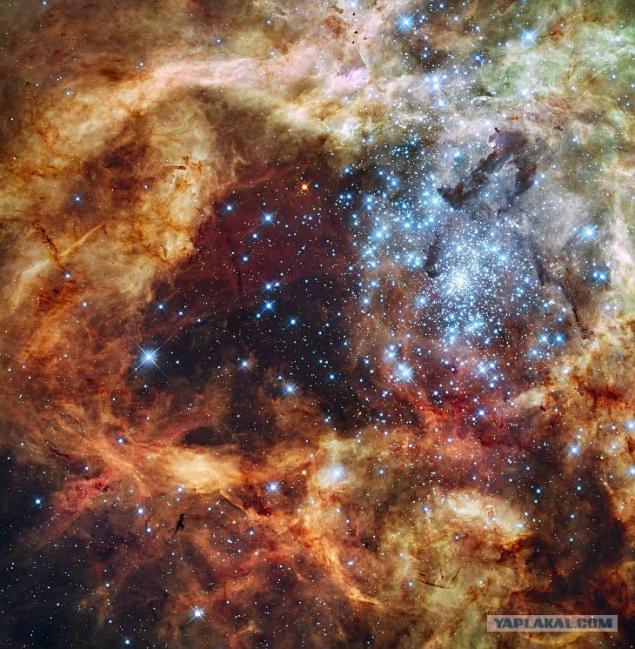
Swan - the constellation of the northern hemisphere of the sky. Tulip Nebula, shown in this photo) consists of glowing interstellar clouds of gas and dust, and is away from us 8000 light years. (Photo by Michael Joner, David Laney):

In this picture, all the stellar tracks appear in concentric circles. This snapshot can be done with only two points on the planet. This picture was taken with an exposure for 24 hours at the South Pole. (Photo by Robert Schwarz (South Pole Station):
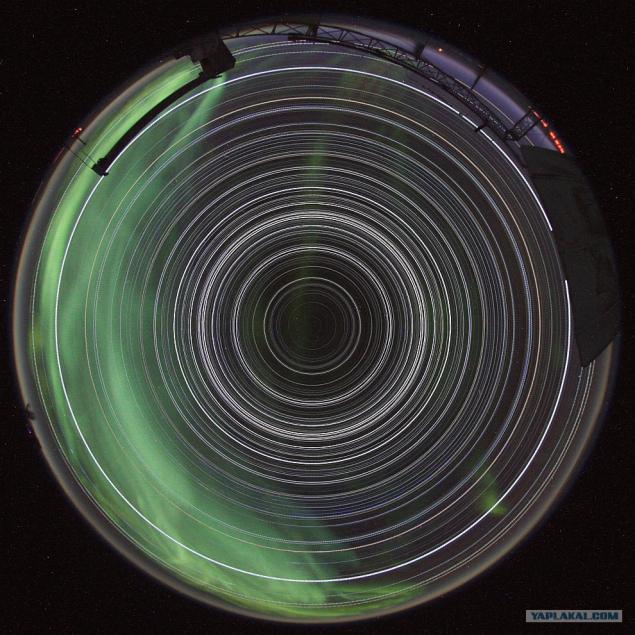
Clusters are 25 thousand light years, and was discovered by German astronomer Gottfried Kirch in 1702. Stretching for 165 light-years across, M5 is one of the largest known stellar globular clusters. With the age of 13 billion years, this cluster is also one of the oldest clusters as part of the Milky Way Galaxy. Cluster contains variously estimated from 100 000 to 500 000 stars. (Photo by Adam Block, Mt. Lemmon SkyCenter, University of Arizona):

This emission nebula in the constellation Cassiopeia. The bubble has a diameter of 10 light years, and it occurs quite turbulent cosmic education. Above and to the right of the center of the bubble is a bright and hot star 45 times more massive, and hundreds of thousands of times brighter than our sun. (Photo by Yves Van den Broek):
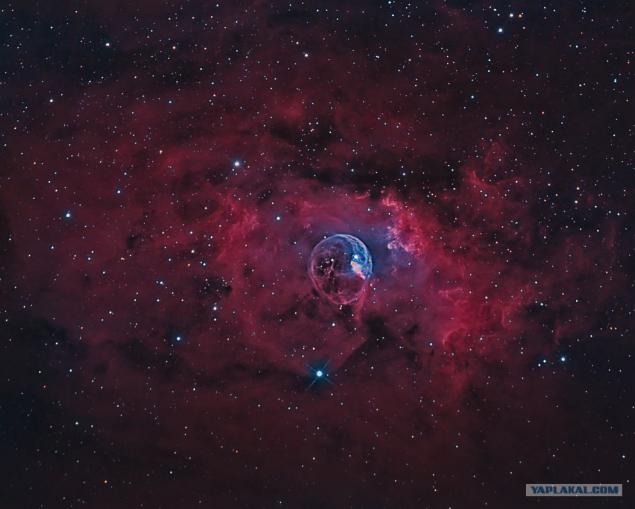
Stunning emission nebula IC 1396, stretching for hundreds of light-years, which mixes glowing cosmic gas and dark dust clouds. In the center of IC 1396 is a bright blue star. (Photo Digitized Sky Survey, ESA / ESO / NASA):

This galaxy is not experiencing the best of times. In fact, over the past 100 million years everything was restless, and probably the next billion years, too, will be quite rapid. Spiral galaxy NGC 4038 (top left) lived their normal lives as long as it does not hit another galaxy - NGC 4039. In the end, the two galaxies will merge into one large spiral galaxy. Such collisions are not uncommon, even our Milky Way galaxy has experienced several such clashes in the past. (Photo Hubble Legacy Archive):
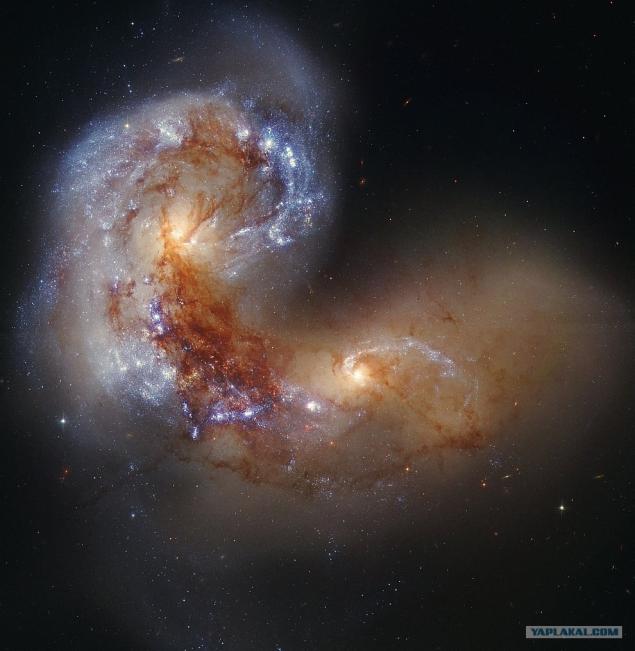
NGC 6888, also known as the Crescent Nebula - is a big cosmic bubble about 25 light-years across, blown by winds from the bright, massive stars at the center. Every 10 000 years from the surface of the star is ejected into space matter equivalent in weight of our sun. Because of this rapid combustion of "fuel" star is in the last stage of his life. Then she will die in a colorful explosion of a supernova. (Photo by J-P Metsavainio (Astro Anarchy):
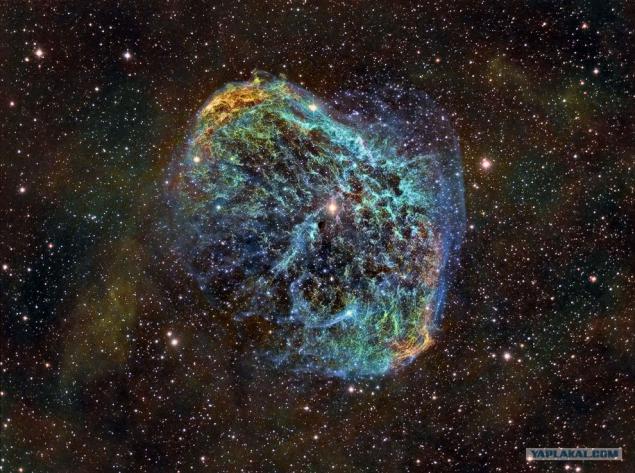
The spiral galaxy NGC 5033 in the constellation Canes Dogs in the 40 million light-years from us. Pink areas - regions of star formation, Blue - clusters of massive stars. Bright light is probably powered by a supermassive black hole. As can be seen, the rotation center of the galaxy is slightly off. This may indicate that NGC 5033 was the result of a merger of other ancient galaxies. (Photo by Adam Block, Mt. Lemmon SkyCenter, University of Arizona):

It is located in the constellation Aquarius at a distance of 53,000 light years from Earth. It was discovered by Pierre Mechain August 29, 1780. Once upon a time dominated by the globular clusters in our Milky Way Galaxy. There were thousands, but most of them were killed when approaching each other. Today there are less than 200 globular clusters in our galaxy, and they are older than any other structures in the Milky Way. Perhaps their age is the age vleplenny ...
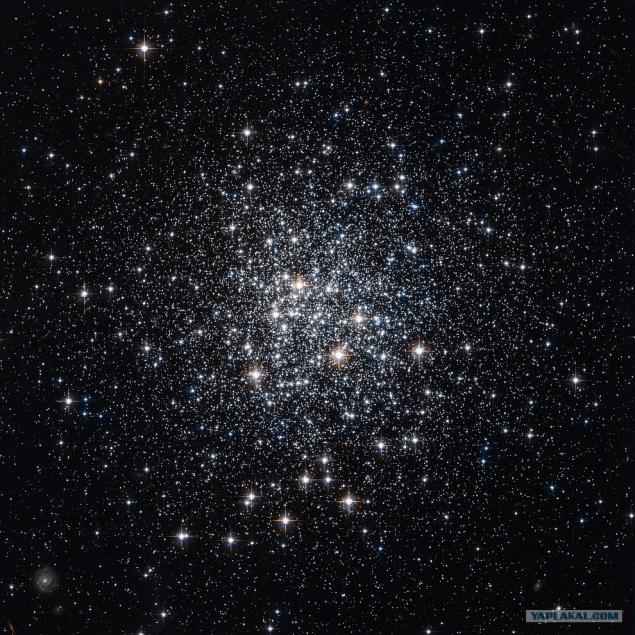
In 3300 light years from Earth (1000 parsecs) dying star that throws off the last layers of glowing gas at 20 trillion tons per second. Cat's Eye Nebula, aka NGC 6543 - a planetary nebula in the constellation Draco. This is one of the most complex structure of nebulae. The central star has a class of O with a temperature of 80,000 K. It is approximately 10 000 times brighter than the Sun!

Why is the sky near Antares and Rho Ophiuchi so colorful? These colors are the result of the interaction of different objects and processes. The red supergiant Antares - one of the brightest stars in the night sky - lights up the yellow-red clouds on the bottom center of the image. Rho Ophiuchi is located in the center of the blue nebula. (Photo by Tom O'Donoghue):
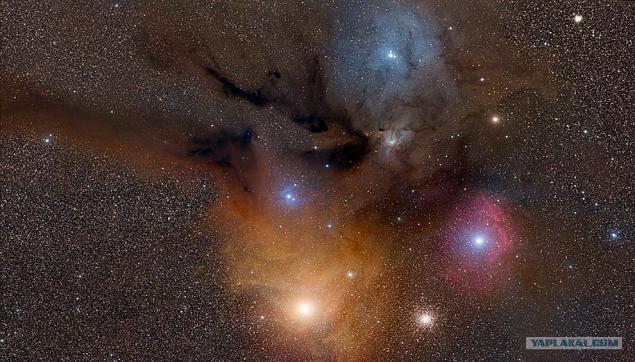
Sometimes also used his own name Seven Sisters. Open cluster in the constellation Taurus; one of the closest to Earth and is one of the most visible to the naked eye star cluster. Pleiades has about 3000 stars, their distance is about 400 light-years. (Photo by Robert Gendler):
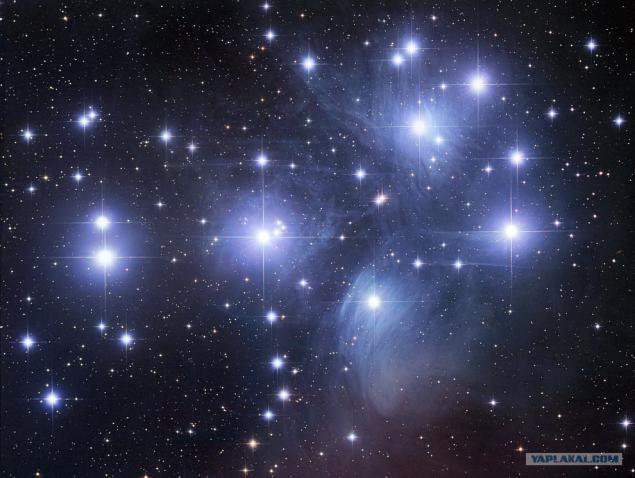
The famous dark nebula in the constellation Orion, located at a distance of 1500 light years from us. The red glow is due to the ionization of hydrogen gas in the mist, the radiation from the nearest bright stars of Orion. (Photo Star Shadows Remote Observatory):

When Saturn's rings appear? Nobody knows exactly. Did they developed relatively recently, compared to the age of the solar system, about 100 million years ago. According to others, the age of some of Saturn's rings may be billions of years old, and they are as old as Saturn itself. (Photo: Cassini Imaging Team, SSI, JPL, ESA, NASA):
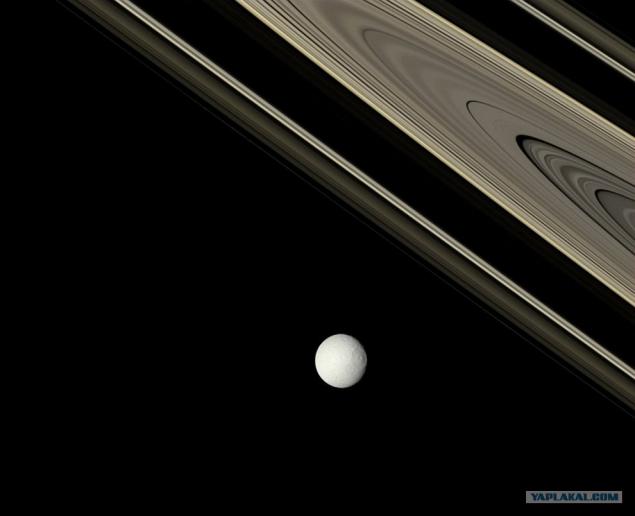
M7 - one of the most famous star clusters in the sky. M7 consists mainly of bright blue stars, its age is about 200 million years old and is at a distance of 1000 light years from Earth. (Photo by Dieter Willasch (Astro-Cabinet):

Next stop: Ceres. Last week, the robot spacecraft "Dawn" ended his year-long mission to the asteroid Vesta, becoming the first spacecraft ever to visit this distant world between Mars and Jupiter in the main asteroid belt of the solar system. The size of Vesta - about 500 kilometers across. Its surface is covered with craters, appeared after heavy clashes. Low gravity allows for Vesta huge mountains, 2 times the size of our Everest (visible at the bottom of the picture). (Photo: NASA, JPL-Caltech, UCLA, MPS, DLR, IDA):

The size of the nebula - about 15 light years and is located in 4000 light years from Earth. The bright star at the center of a very young, her age, probably only a few hundred thousand years. (Photo by Fabian Neyer):

Odd Couple - giant elliptical galaxy M60 and the spiral galaxy NGC 4647. A bright M60 is located 54 million light-years from us, and consists of randomly moving (changing slightly) older stars. Spiral galaxy NGC 4647 is located 63 million light-years from Earth and is composed of young blue stars. (Photo: NASA, ESA, Hubble Heritage Team):

This cloud of gas unusual shape - Pencil Nebula formed in a supernova explosion about 11 000 years ago. First, the shock wave from the explosion was moving at a speed of several million kilometers per hour, is now the wave is in space at a speed of just over 500 000 kilometers per hour. Length Pencil Nebula - about 5 light years, it is located at a distance of 800 light years from Earth. (Photo: ESO):

The distance to the nebula Shrimp is about 6000 light-years. Hot, massive stars, age is only a few million years, light nebula invisible ultraviolet radiation. (Photo: Marco Lorenzi (Glittering Lights):
PS: the accuracy of information do not answer honestly steal
All.

Source:
steal here
In the constellation of Dorado is a huge cluster of R136, which consists of the largest, hottest, most massive stars known. It contains more than 100,000 stars. The total mass of the cluster R136 is estimated at 450,000 solar masses. Here are 12 very massive and bright stars from 37 to 76 mass of our sun. (Photo: NASA, ESA):

Swan - the constellation of the northern hemisphere of the sky. Tulip Nebula, shown in this photo) consists of glowing interstellar clouds of gas and dust, and is away from us 8000 light years. (Photo by Michael Joner, David Laney):

In this picture, all the stellar tracks appear in concentric circles. This snapshot can be done with only two points on the planet. This picture was taken with an exposure for 24 hours at the South Pole. (Photo by Robert Schwarz (South Pole Station):

Clusters are 25 thousand light years, and was discovered by German astronomer Gottfried Kirch in 1702. Stretching for 165 light-years across, M5 is one of the largest known stellar globular clusters. With the age of 13 billion years, this cluster is also one of the oldest clusters as part of the Milky Way Galaxy. Cluster contains variously estimated from 100 000 to 500 000 stars. (Photo by Adam Block, Mt. Lemmon SkyCenter, University of Arizona):

This emission nebula in the constellation Cassiopeia. The bubble has a diameter of 10 light years, and it occurs quite turbulent cosmic education. Above and to the right of the center of the bubble is a bright and hot star 45 times more massive, and hundreds of thousands of times brighter than our sun. (Photo by Yves Van den Broek):

Stunning emission nebula IC 1396, stretching for hundreds of light-years, which mixes glowing cosmic gas and dark dust clouds. In the center of IC 1396 is a bright blue star. (Photo Digitized Sky Survey, ESA / ESO / NASA):

This galaxy is not experiencing the best of times. In fact, over the past 100 million years everything was restless, and probably the next billion years, too, will be quite rapid. Spiral galaxy NGC 4038 (top left) lived their normal lives as long as it does not hit another galaxy - NGC 4039. In the end, the two galaxies will merge into one large spiral galaxy. Such collisions are not uncommon, even our Milky Way galaxy has experienced several such clashes in the past. (Photo Hubble Legacy Archive):

NGC 6888, also known as the Crescent Nebula - is a big cosmic bubble about 25 light-years across, blown by winds from the bright, massive stars at the center. Every 10 000 years from the surface of the star is ejected into space matter equivalent in weight of our sun. Because of this rapid combustion of "fuel" star is in the last stage of his life. Then she will die in a colorful explosion of a supernova. (Photo by J-P Metsavainio (Astro Anarchy):

The spiral galaxy NGC 5033 in the constellation Canes Dogs in the 40 million light-years from us. Pink areas - regions of star formation, Blue - clusters of massive stars. Bright light is probably powered by a supermassive black hole. As can be seen, the rotation center of the galaxy is slightly off. This may indicate that NGC 5033 was the result of a merger of other ancient galaxies. (Photo by Adam Block, Mt. Lemmon SkyCenter, University of Arizona):

It is located in the constellation Aquarius at a distance of 53,000 light years from Earth. It was discovered by Pierre Mechain August 29, 1780. Once upon a time dominated by the globular clusters in our Milky Way Galaxy. There were thousands, but most of them were killed when approaching each other. Today there are less than 200 globular clusters in our galaxy, and they are older than any other structures in the Milky Way. Perhaps their age is the age vleplenny ...

In 3300 light years from Earth (1000 parsecs) dying star that throws off the last layers of glowing gas at 20 trillion tons per second. Cat's Eye Nebula, aka NGC 6543 - a planetary nebula in the constellation Draco. This is one of the most complex structure of nebulae. The central star has a class of O with a temperature of 80,000 K. It is approximately 10 000 times brighter than the Sun!

Why is the sky near Antares and Rho Ophiuchi so colorful? These colors are the result of the interaction of different objects and processes. The red supergiant Antares - one of the brightest stars in the night sky - lights up the yellow-red clouds on the bottom center of the image. Rho Ophiuchi is located in the center of the blue nebula. (Photo by Tom O'Donoghue):

Sometimes also used his own name Seven Sisters. Open cluster in the constellation Taurus; one of the closest to Earth and is one of the most visible to the naked eye star cluster. Pleiades has about 3000 stars, their distance is about 400 light-years. (Photo by Robert Gendler):

The famous dark nebula in the constellation Orion, located at a distance of 1500 light years from us. The red glow is due to the ionization of hydrogen gas in the mist, the radiation from the nearest bright stars of Orion. (Photo Star Shadows Remote Observatory):

When Saturn's rings appear? Nobody knows exactly. Did they developed relatively recently, compared to the age of the solar system, about 100 million years ago. According to others, the age of some of Saturn's rings may be billions of years old, and they are as old as Saturn itself. (Photo: Cassini Imaging Team, SSI, JPL, ESA, NASA):

M7 - one of the most famous star clusters in the sky. M7 consists mainly of bright blue stars, its age is about 200 million years old and is at a distance of 1000 light years from Earth. (Photo by Dieter Willasch (Astro-Cabinet):

Next stop: Ceres. Last week, the robot spacecraft "Dawn" ended his year-long mission to the asteroid Vesta, becoming the first spacecraft ever to visit this distant world between Mars and Jupiter in the main asteroid belt of the solar system. The size of Vesta - about 500 kilometers across. Its surface is covered with craters, appeared after heavy clashes. Low gravity allows for Vesta huge mountains, 2 times the size of our Everest (visible at the bottom of the picture). (Photo: NASA, JPL-Caltech, UCLA, MPS, DLR, IDA):

The size of the nebula - about 15 light years and is located in 4000 light years from Earth. The bright star at the center of a very young, her age, probably only a few hundred thousand years. (Photo by Fabian Neyer):

Odd Couple - giant elliptical galaxy M60 and the spiral galaxy NGC 4647. A bright M60 is located 54 million light-years from us, and consists of randomly moving (changing slightly) older stars. Spiral galaxy NGC 4647 is located 63 million light-years from Earth and is composed of young blue stars. (Photo: NASA, ESA, Hubble Heritage Team):

This cloud of gas unusual shape - Pencil Nebula formed in a supernova explosion about 11 000 years ago. First, the shock wave from the explosion was moving at a speed of several million kilometers per hour, is now the wave is in space at a speed of just over 500 000 kilometers per hour. Length Pencil Nebula - about 5 light years, it is located at a distance of 800 light years from Earth. (Photo: ESO):

The distance to the nebula Shrimp is about 6000 light-years. Hot, massive stars, age is only a few million years, light nebula invisible ultraviolet radiation. (Photo: Marco Lorenzi (Glittering Lights):
PS: the accuracy of information do not answer honestly steal
All.

Source:
Tags
See also
The most beautiful fish
Best pictures from the telescope "Hubble" (Part One)
Note: Stars talk about the most beautiful representative of the zodiacal pantheon!
8 most beautiful landscapes of the world of water
Panoramas of the most beautiful places on Earth
Rostov. The most beautiful ceremonial
Beautiful photos of the highest mountain in the world - Mount Everest
Some of the most beautiful covers heavy metal!
The most beautiful places of Ukraine appeared in Google Maps
The most beautiful girls.

















